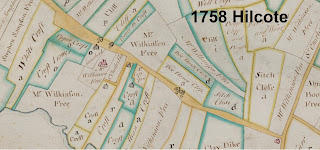Blackwell in 1758
In 1742 The Duke of Newcastle sold
several holdings of land in Derbyshire to the Duke of Devonshire. Included in
this sale was the Manor and Farms of Blackwell, in it’s villages of (Old)
Blackwell , Newton and Hilcote. The valuation at that time lists 23 tenants in
properties included in the sale.
In 1758 The Duke commissioned a map of Blackwell which shows all the fields, those which are in the use of the Duke’s tenants and those which owned by others. There is a copy of this map in each of Blackwell Parish’s Community Centres. Many of the field boundaries and lanes in 1758 still exist today and are easily recognisable on the map. For example, Fordbridge Lane with its bend around the A Winning Colliery site, had the same bend 100 years before the Colliery was established. And the field at the side was named “ Fordbridge”.
In 1758 The Duke commissioned a map of Blackwell which shows all the fields, those which are in the use of the Duke’s tenants and those which owned by others. There is a copy of this map in each of Blackwell Parish’s Community Centres. Many of the field boundaries and lanes in 1758 still exist today and are easily recognisable on the map. For example, Fordbridge Lane with its bend around the A Winning Colliery site, had the same bend 100 years before the Colliery was established. And the field at the side was named “ Fordbridge”.
In total there are 58 dwellings shown on the map; 24 are in
“Old” Blackwell including 1 at Twinyards and 1 near Revill’s Hill; 21 in
Newton, 10 in Hilcote, 2 in ”New” Blackwell, at Scanderlands and Hill Top. And
1 in Westhouses approx. where the Station Hotel now stands. Some of these
dwellings still exist although most are considerably changed during the last
300 years. Notes in this extract from the map list some of the property
locations, some numbered on the map and who owned or tenanted them. The notes
are retyped here. In brackets is shown the location as now known.
1,
Frog Holes . 2/3 Sir Charles Molyneaux ( of Teversal) 1/3 The Duke’s (
Devonshire), Mr Wilkinson Tenant.
2,
Horse Mill Lane Pingle.
Ditto
Ditto
Ditto ( Opposite End
Fordbridge Lane)
3,
Mary Watson’s Sough Pingle ( Behind Hilcote Community Centre)
4,
Willm Struts Croft (Adjacent
to St Werburgh’s)
5,
George Alsops Croft (
Adjacent to St Werburgh’s)
6,
Stone quarry Close .1/2 George Adlington’s, ½ Mr Wilkinson’s Freehold ( Approx. at Twinyards Farm)
8,
Willm Downend’s Hodsetting Pingle, exchanged with Sir Charles Molyneaux ……for Elias Boot’s Croft and half of Mr
Rowson’s Shepherd Flat ( Shepherd Flat was at the side of Pipes Farm,
now under the M1 Motorway)
9,10,11,12,13,14,15,
Cottages on the Waste, part in Possession ofLabourers, ….and part in the
Farmers…….
( These were at the bottom of Church
Hill in the lane itself)
16,17,18,
19, The poor’s Houses
(16 and 17 were opposite Hilcote Hall
in Hilcote Lane, and 18 and 19 on Alfreton Rd close to the Cragg Lane Corner)
20,21,
Cottage Houses (
20 is on the corner of The Green in Newton and 21 close by in Littlemoor Lane)
The locations of “1, Frog Holes” and “8, Willm Downend’s Hodsetting Pingle” have not been identified, but there were some
other entertaining field names…. for example ”Cat Pool”, “Cockbarrow”, several
“Swans Nests”, “Twin Yates”. There were several Pit Lands or Closes where coal in
the seams close to the surface would have been extracted by Bell Pits like the
one shown here. There were many lanes which have now disappeared either under
the M1 or just lost, a significant one being from Mount Pleasant down to
Hilcote Lane almost directly opposite Fordbridge Lane end. At some time it was
known as Strawberry Lane, and if you now look through the fields from Hilcote
Lane you can see two oak trees between
which Strawberry Lane would have run.
When next you visit the community centres
take a look at the map, and go back almost 300 years in the history of Blackwell.






